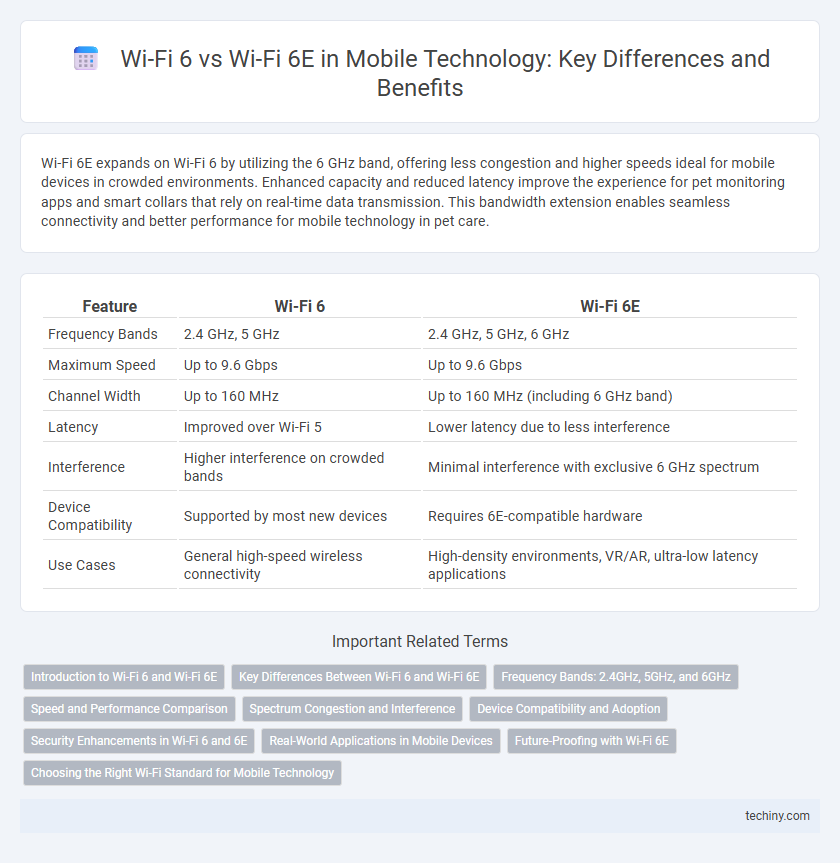Wi-Fi 6E expands on Wi-Fi 6 by utilizing the 6 GHz band, offering less congestion and higher speeds ideal for mobile devices in crowded environments. Enhanced capacity and reduced latency improve the experience for pet monitoring apps and smart collars that rely on real-time data transmission. This bandwidth extension enables seamless connectivity and better performance for mobile technology in pet care.
Table of Comparison
| Feature | Wi-Fi 6 | Wi-Fi 6E |
|---|---|---|
| Frequency Bands | 2.4 GHz, 5 GHz | 2.4 GHz, 5 GHz, 6 GHz |
| Maximum Speed | Up to 9.6 Gbps | Up to 9.6 Gbps |
| Channel Width | Up to 160 MHz | Up to 160 MHz (including 6 GHz band) |
| Latency | Improved over Wi-Fi 5 | Lower latency due to less interference |
| Interference | Higher interference on crowded bands | Minimal interference with exclusive 6 GHz spectrum |
| Device Compatibility | Supported by most new devices | Requires 6E-compatible hardware |
| Use Cases | General high-speed wireless connectivity | High-density environments, VR/AR, ultra-low latency applications |
Introduction to Wi-Fi 6 and Wi-Fi 6E
Wi-Fi 6, also known as 802.11ax, significantly enhances network efficiency and speed by operating on the 2.4 GHz and 5 GHz bands and supporting technologies like OFDMA and MU-MIMO. Wi-Fi 6E extends these capabilities by adding access to the 6 GHz spectrum, offering greater bandwidth, reduced interference, and improved performance for high-density environments. This expansion enables faster data transfer rates and lower latency, making Wi-Fi 6E ideal for emerging applications such as augmented reality and ultra-high-definition streaming.
Key Differences Between Wi-Fi 6 and Wi-Fi 6E
Wi-Fi 6 operates primarily on the 2.4 GHz and 5 GHz bands, while Wi-Fi 6E extends this capability by utilizing the new 6 GHz frequency spectrum, offering less interference and higher throughput. Wi-Fi 6E supports up to 14 additional 80 MHz channels and 7 additional 160 MHz channels compared to Wi-Fi 6, significantly enhancing capacity and reducing latency in dense environments. The expanded spectrum in Wi-Fi 6E enables improved performance for bandwidth-intensive applications such as virtual reality and 4K streaming, making it ideal for environments requiring ultra-fast and reliable connectivity.
Frequency Bands: 2.4GHz, 5GHz, and 6GHz
Wi-Fi 6 operates on the 2.4GHz and 5GHz frequency bands, delivering improved speed and capacity compared to previous Wi-Fi standards. Wi-Fi 6E extends these capabilities by utilizing the newly available 6GHz band, offering significantly more spectrum, reduced interference, and higher throughput for advanced mobile technology applications. The 6GHz band in Wi-Fi 6E supports low-latency connections and enhanced performance in densely populated networks, optimizing wireless experiences on compatible mobile devices.
Speed and Performance Comparison
Wi-Fi 6E extends Wi-Fi 6 by operating in the 6 GHz band, delivering faster speeds and reduced latency due to less congestion and increased spectrum availability. The wider channels in Wi-Fi 6E enable peak data rates exceeding 9.6 Gbps, outperforming Wi-Fi 6's maximum speed of 3.5 Gbps in the 2.4 GHz and 5 GHz bands. Enhanced performance in Wi-Fi 6E supports high-demand mobile applications, offering more reliable connections in dense environments.
Spectrum Congestion and Interference
Wi-Fi 6E operates in the 6 GHz band, offering significantly more spectrum and reducing congestion compared to Wi-Fi 6, which is limited to the 2.4 GHz and 5 GHz bands. The expanded spectrum in Wi-Fi 6E enables lower latency and less interference, especially in dense environments with numerous connected devices. Wi-Fi 6 often experiences interference from legacy devices and overlapping networks, while Wi-Fi 6E provides cleaner channels for enhanced wireless performance.
Device Compatibility and Adoption
Wi-Fi 6E extends Wi-Fi 6 by adding the 6 GHz band, requiring compatible devices to support this new spectrum for optimal performance. While Wi-Fi 6 devices operate on 2.4 GHz and 5 GHz bands, Wi-Fi 6E adoption depends on mobile devices, routers, and chipsets designed to handle the additional 6 GHz frequencies. Current device compatibility limits widespread Wi-Fi 6E adoption, but increasing integration in smartphones, laptops, and IoT devices will drive accelerated market penetration.
Security Enhancements in Wi-Fi 6 and 6E
Wi-Fi 6 and Wi-Fi 6E both offer advanced security features based on WPA3, providing improved protection against brute-force attacks and enhanced encryption for sensitive data. Wi-Fi 6E extends these security enhancements by operating in the less congested 6 GHz band, reducing interference and potential vulnerabilities from overlapping networks. The combination of robust encryption protocols and access to additional spectrum in Wi-Fi 6E delivers stronger overall security for mobile devices and IoT applications.
Real-World Applications in Mobile Devices
Wi-Fi 6E extends Wi-Fi 6 by operating in the 6 GHz band, offering less congestion and higher throughput, crucial for mobile devices requiring ultra-fast, low-latency connections in dense environments. Enhanced bandwidth in Wi-Fi 6E supports seamless streaming, gaming, and VR applications on smartphones and tablets with minimal interference. Real-world performance improvements make Wi-Fi 6E ideal for next-gen mobile devices demanding reliable, high-capacity wireless connectivity.
Future-Proofing with Wi-Fi 6E
Wi-Fi 6E extends the capabilities of Wi-Fi 6 by operating in the newly allocated 6 GHz spectrum, offering significantly less congestion and higher throughput for emerging mobile devices. This expansion enables future-proofing through enhanced bandwidth, lower latency, and improved performance in dense environments, supporting advanced applications such as augmented reality and 8K streaming. Adoption of Wi-Fi 6E ensures compatibility with next-generation mobile technology demands, providing a robust wireless infrastructure for years to come.
Choosing the Right Wi-Fi Standard for Mobile Technology
Wi-Fi 6E extends Wi-Fi 6 by utilizing the 6 GHz band, offering higher capacity, lower latency, and reduced interference, which is crucial for high-density mobile environments and faster data transmission. Choosing Wi-Fi 6E benefits mobile devices requiring enhanced performance for AR/VR applications and seamless streaming, while Wi-Fi 6 remains suitable for general mobile use with solid reliability and widespread compatibility. Mobile technology stakeholders must evaluate device capabilities and network demands to select the optimal Wi-Fi standard that balances speed, coverage, and spectrum availability.
Wi-Fi 6 vs Wi-Fi 6E Infographic

 techiny.com
techiny.com